It’s been a while since the zero-day attack spread around the world. This attack takes advantage of unknown software, hardware, or firmware security vulnerabilities. If you leave this attack unsolved in your system, malicious actors will utilize it to harm your organization.
Ahead, let’s take a closer look at how it works, who carries it out, real-life examples, how to identify and prevent it, and who the main targets are. Let’s go!
What is a Zero-Day Exploit?

A zero-day exploit is a cyber threat method that exploits previously unknown vulnerabilities in software, hardware, or firmware.
The term “zero-day” emphasizes that developers or vendors have had zero days to address or patch the flaw. Attackers are already using the attack to compromise systems before the target knows about the zero-day vulnerability, giving the target no time to prepare or mitigate the attack.
How Do Zero-Day Attacks Work?

Attackers launch this attack by spotting software, hardware, or firmware vulnerabilities before developers notice them and create a patch. With the vulnerabilities wide open, attackers can write and implement “exploit code”, to exploit the data.
As a result, this malicious code can harm the users, such as data theft or other cybercrime.
One way attackers can reach the vulnerable system is by employing socially engineered email. Users who click the malicious link inside the email will download malware that will infiltrate their files and steal their data.
Further, attackers can sell these data exploits on the dark web for a huge amount of money.
Until the developers notice and patch these vulnerabilities, it is still considered a threat.
Who Carries Out Zero-Day Attacks?

Various actors carry out this attack, including:
Hacktivists
These people launch an attack to draw attention to their cause of social or political issues.
Cyberwarfare
Cyberwarfare is another level of cyber attack, as a country performs a spy or attack on another country’s cyberinfrastructure.
Cybercriminals
This is the most common zero-day attack actor, as they perform an attack for financial gain.
Corporate Espionage
Living up to its name, this attack is launched by attackers who want to spy on a corporation to gain information about them.
Examples of Zero-Day Attacks

After years of looming around the cyberinfrastructure, several prominent zero-day attack examples broke the internet. Here are some of them:
Log4Shell
The Log4Shell vulnerability was a critical zero-day flaw in the widely used Log4J Java logging library. It allowed remote control of devices with Java applications. It affected numerous devices globally, including those using Apple iCloud and Minecraft.
Identified in 2013 but exploited in 2021, it received a maximum severity score from MITRE’s CVE database. Despite a quick patch, attacks peaked at over 100 per minute.
2022 Chrome Attacks
In 2022, North Korean hackers exploited a zero-day vulnerability in Google Chrome. Through phishing emails, they directed victims to spoofed sites that leveraged the Chrome flaw to install spyware and remote access malware on their machines.
Although the vulnerability was swiftly patched, the hackers managed to conceal their actions, leaving researchers uncertain about the extent of the data stolen.
Stuxnet
Stuxnet, a notorious computer worm, exploited four zero-day vulnerabilities in Microsoft Windows. In 2010, it targeted Iran’s nuclear facilities, infiltrating their computer systems and issuing malicious commands to uranium-enriching centrifuges. These commands caused the centrifuges to spin uncontrollably, damaging 1,000 units.
While speculation suggests that the US and Israeli governments collaborated on Stuxnet’s creation, this still needs to be confirmed.
The story of Stuxnet was later captured in the documentary Zero Days.
How to Identify Zero-Day Attacks

Information about zero-day exploits becomes available only after the exploit is identified due to their unique nature. However, there are several detection efforts available, including:
- Taking advantage of pre-existing databases of malware and their behavior as references.
- Look for the characteristics of zero-day attacks based on their interaction with the system of the target.
- Utilize machine learning from previous exploit records to increase the reliability of the detection system.
How to Prevent Zero-Day Attacks

Preventing zero-day attacks need multisteps. Here are some efforts you can do:
Threat Prevention Engines
Threat prevention engines help provide the required protection from attacks, allowing developers to take action eventually. Some of the required engine abilities include CPU level inspection, anti-bot, and anti-exploit.
Security Consolidation
Establishing unified security consolidation is vital to preventing attacks. This platform effectively allows the IT team to control the entire ecosystem, resulting in immediate attack responses.
Threat Intelligence Platforms
Threat prevention engines need information about previously experienced attacks to detect future attacks successfully, and quality threat intelligence platforms help provide this information.
Who are the Targets for Zero-Day Exploits?

The targets of these exploits vary from operating systems to web browsers. As a result, there are myriad potential victims from small to large scales, such as individuals with vulnerable systems, hardware devices, IoT, large organizations, government agencies, and political targets.
Frequently Asked Questions
Why are zero-day attacks so effective?
Zero-day attacks are highly effective because they exploit unknown vulnerabilities, leaving developers no time to create defenses or patches and allowing attackers to infiltrate systems quickly.
Why is it called zero-day?
It refers to the timing of the vulnerability. When a security flaw is discovered, it is assigned a “day zero” because it is the day the vulnerability becomes known.
How can we defend zero-day vulnerability?
Some defense strategies include web application firewalls, network segregation, access control, responsive patching, and user awareness training.
Conclusion
Dealing with a zero-day attack requires multiple steps, from having a robust early identification and prevention system to implementing defense strategies to patch up zero-day vulnerabilities. Ensure you are not an easy target for this attack by being alert and regularly updating security patches of your software or other devices.
For further assistance with this issue, contact Fluxgate now!
